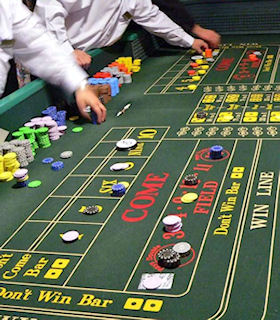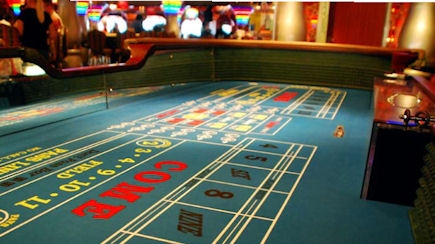In part C we are going to explain the ‘come’ bet, a bet often neglected in Macau. Maybe after this article, that will all change.
Come betting is exactly the same as pass line betting but it feels different. If you need to refresh your memory on pass line betting visit our website and see part A of this craps series. Come betting can only be done during the point cycle (that is, after a point of 4, 5, 6, 8, 9 or 10 has been established). To make a ‘come’ bet place your chips in the big box marked ‘COME’ above the area of the layout marked ‘FIELD’ (we will explain the field bet in a later article). Even though the game is in the point cycle, this roll will be treated as the first roll of a new game (a come out roll) for your come bet. The come bet is great if you missed the come out roll (for example, maybe you just walked up to the table during a point cycle). Or maybe you just got tired of waiting for the shooter to hit his point or a 7 during the point cycle, and you want more action!
Because come bets are essentially the same as pass line bets, a roll of 7 or 11 are natural winners and a roll of 2, 3 or 12 (craps) are immediate losers. Because the bet is made during the point cycle when your come bet wins with a 7 that roll is actually a 7-out for all the pass line and place bets – so don’t expect the table to be cheering your win! If a point number is rolled your come bet now behaves just like a pass line bet and moves into the point cycle – with a different point to the pass line bets. The dealer indicates this by moving the bet to your point number’s box on the layout on the outside portion of the box to show that it started its life as a come bet

Just like any normal pass line bet you may also take odds on your come bet once a point number is established – this is just like betting ‘behind the line’ as explained in part A. Simply drop your money for the odds bet on the layout and tell the dealer you would like to take the odds, and he will move your chips to the point number. He will ‘heel’ the chips slightly to show which portion of your bet is the normal ‘pass line’ part and which portion is the ‘odds’. You may take the same amount of odds that is available if you had a pass line bet. Again see part A of this series for detailed discussion of betting at true odds ‘behind the line’.
Repeated come bets can mean many chips end up on many different point numbers. This kind of complexity on the layout is part of the joy of craps. Experienced craps players take a kind of perverse pleasure in the apparent chaos of a heavily plastered layout!
When you hit a point number that started life as a come bet, you are paid just like a winning pass line bet (including any ‘behind the line’ odds you may have taken) and the game is over for your come bet. If you had another come bet on that roll your subsequent come bet is moved to the number that has just been hit and the whole cycle on that number continues. Come betting is a great bet for those people who like to get more money on the layout at true odds. In fact, you can have a come bet on every roll of the dice during point cycles and if the point cycle lasts a long time you can find yourself ‘loading up the bases’ to the point that you are winning on every box number: 4, 5, 6, 8, 9 and 10.
There is nothing more exciting in craps than ‘loaded bases’ with full ‘behind the line’ odds and having perpetual come bets, while the shooter hits number after number after number. Any number 4, 5, 6, 8, 9 or 10 means a big win for you (most of it at true odds) and even an 11 means a small win (because that’s a natural winner for your come bet). Hitting a 2, 3 or 12 just means a relatively minor loss (of the come bet) which is quickly replaced and the ‘main game’ of trying to hit box numbers goes on. Only the dreaded 7 will cause you major pain – because it means all the money on the box numbers will be lost (as a consolation you will win your last come bet). This kind of ‘loaded bases’ situation with repeated numbers being hit is the stuff craps players dream of. Players have been known to go on extended runs – the world record being a mind-boggling streak of 154 dice rolls without sevening-out!
During a craps game a dealer known as the ‘stick man’ often says various phrases to control and explain the game, usually in a loud, almost singing voice. Many stick men develop humorous patter and expressions that rhyme. When a 7-out is rolled many stickmen will sing out “7 out, the line’s away, the don’ts to pay, last come will get some” meaning a 7 has been rolled, the pass line bets lose, the ‘don’t win’ bets will win (‘don’t’ betting will be explained in a later part of this series), and any come bets on the layout win.
In part D of our craps series I’ll introduce you to the proposition bets that are in the centre of the table. Many players consider these middle-of-the-table ‘prop’ bets fun to play, and they often have crazysounding names like ‘horn high’, ‘the world’ and ‘hopping hard-ways’!







